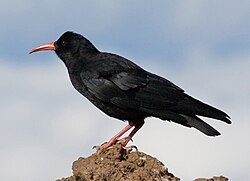(Red-billed choughs, Pyrrhocorax pyrrhocorax, were one of several cliff-loving species found at Paleolithic sites. Image courtesy of Wikipedia.)
This finding is exciting for two main reasons. First, to quote the authors directly, "regular and systematic exploitation of flying birds for food is considered to be a hallmark of behavioural modernity, exclusive to anatomically modern Homo sapiens after 50 thousand years ago." Although there have been a few previous findings indicating that birds were an occasional prey item of Neanderthals, researchers have typically argued that use of avian species was "opportunistic and unsystematic." Thus, any evidence that Neanderthals repeatedly collected birds (regardless of how the animals were eventually used) indicates that we humans were not the only hominins capable of recognizing the potential of these particular sources of material--not to mention figuring out how to go about getting them.
The second point of interest pertains to the use of birds not for meat--or, at least, not just for meat--but for feathers and claws. Given how these bits were utilized by early humans, as well as by human descendants in nearly every known culture around the world, it is likely that the Neanderthals were collecting these features for personal ornaments or some other decorative purpose. This sort of behavior has generally been considered beyond the capacity of Neanderthals, and so the new evidence is suggestive of "unprecedented cognitive abilities."
(Cut-marks from early stone tools were found on many bird bones at three sites in Gibraltar--Gorham's, Vanguard, and Ibex Caves. Image courtesy of PLoS ONE.)
Aware that this possibility might be met with skepticism, the authors were sure to perform as comprehensive a study as possible. They first compiled a database of 1,699 archaeological and paleontological sites in which avian fossils had been identified. They were particularly interested in raptors and corvids because these two groups of birds are often seen around human settlements and so seemed particularly likely to be accessible to early hunters. An analysis of the database revealed that both Middle Paleolithic sites (those associated with Neanderthals) and Upper Paleolithic sites (those associated with modern humans) contained more raptor and corvid species than paleontological sites. Particularly common were birds that are scavengers, colonial nesters, and/or cliff-dwellers, indicating that hominin hunters were reacting to "a strong ecological signal." Also common--especially in Neanderthal-era sites--were birds with dark wing feathers. If, as this suggests, Neanderthals were specifically targeting species with certain physical characteristics, then these artifacts are evidence of "sophisticated cognitive processes" not previously attributed to these early hominins.
Detailed examinations of 604 "skeletal elements" from 21 species of bird revealed many signs of hominin processing: cut-marks made by Neanderthal stone tools, bones broken just after the birds had died, burns, tooth imprints, and--especially interesting--overextension of the ulnae and humeri. In other words, the wings had been stretched as their feathers were plucked out. The wings had received considerably more attention than other parts of the birds' bodies, and the authors found no evidence that the preponderance of wing bones at their study sites resulted from anything other than especially high levels of hominin interest in these parts of the bird anatomy.
(Map showing the Paleolithic and paleontological sites containing more than 50% of the 18 raptor/corvid species cataloged across the study area. Image courtesy of PLoS ONE.)
Although many of the examined sites were quite distant from each other--2,000 km separate Riparo Fumane and Gibraltar, for example--the authors could still see a "clear concentration across the western mid-latitude belt." The habitats in these areas are relatively similar, granting Neanderthals and early modern humans consistent access to the same types of bird species. What remains unclear, however, is what sort of forces led hominins in these areas to display similar levels of interest in the wing feathers of raptors and corvids. Did a shared ancestor of both Neanderthals and modern humans pass down this cultural characteristic? Was there behavioral convergence of two groups living in the same region? Is it possible that Neanderthals could have transmitted this trait to modern humans?
Given the current evidence, this may be difficult to determine; for now, the best the authors can do is point out that feather use is a "common characteristic of the two lineages." Further, Neanderthals arrived in Europe several thousand years before modern humans did, and therefore engaged in feather-plucking activities in isolation. Thus, no matter how they learned this behavior and regardless of whatever other mental skills they may have had, these early hominins often maligned for their lack of intellect were clearly capable of "cognitive capacities that included symbolic expression"--a characteristic that the authors feel renders them "distinctly human."
---
Finlayson, C., Brown, K., Blasco, R., Rossell, J., Negro, J.J., Bortolotti, G.R., Finlayson, G., Marco, A.S., Pacheco, F.G., Vidal, J.R., Carrion, J.S., Fa, D.A., and Llanes, J.M.R. 2012. Birds of a feather: Neanderthal exploitation of raptors and corvids. PLoS ONE 7(9):e45927.

No comments:
Post a Comment